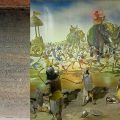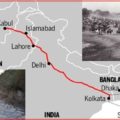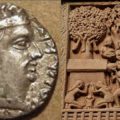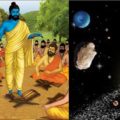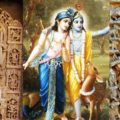53 Evidences on Mahabharata War Date; Brihadratha to Gupta Chronology
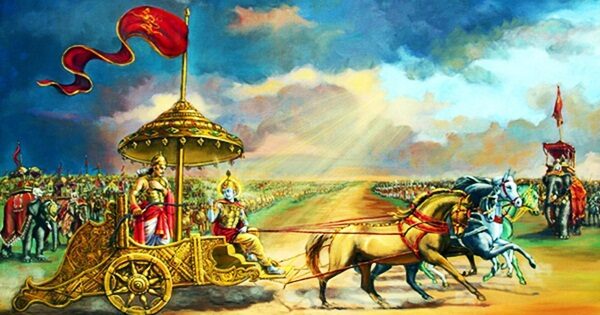
Our historical texts like Puranas etc., give the continuous chronology starting from the Kurukshetra war. Therefore, the Mahabharata War date cannot be fixed in isolation. It is expected that every researcher of Indian chronology should not only attempt to fix the date of Kurukshetra war but also arrive at the chronology from the Brihadratha dynasty to the Gupta dynasty.
Thus, it is pertinent to reconcile the date with other important historical references, which helps put the date in proper perspective. The following internal, external, traditional, epigraphic, chronological and scientific evidences are suggested for corroborating the proposed date of Kurukshetra war so that the accuracy of Mahabharata War date can be comprehensively validated.
Dating and methodology:

Internal Evidence of Mahabharata War Date
1. Yuga Chronology: Kurukshetra War took place at the end of Dvapara Yuga.
अन्तरेचैवसंप्राप्तेकलिद्वापरयॊरभूत्
समन्तपञ्चकेयुद्धंकुरुपाण्डवसेनयॊःII (Adi Parva 2.9)
2. Kaliyuga had already commenced before Mahabharata War.
कौमुदेमासिरेवत्यांशरदन्तेहिमागमे,
स्फीतसस्यमुखेकालेकले:सत्त्ववतांवरः॥(Udyoga Parva 8.17)
यस्मिन्यत्नःकृतॊऽस्माभिःसनॊहीनःप्रयत्नतः,
अकृतेतुप्रयत्नेऽस्मान्उपावृत्तःकलिर्महान्॥
एतत्कलियुगंनामअचिराद्यत्प्रवर्तते
युगानुवर्तनंत्वेतत्कुर्वन्तिचिरजीविनःII (Vana Parva 148.37)
प्राप्तं कलियुगं विद्धि प्रतिज्ञां पाण्डवस्य च
आनृण्यं यातु वैरस्य प्रतिज्ञायाश्च पाण्डवः II (Shalya Parva 59.21)
3. Arundhati walked ahead / rose before Vasishtha
उभेसंध्येप्रकाशेतेदिशांदाहसमन्विते।
आसीद्रुधिरवर्षंचअस्थिवर्षंचभारत॥
याचैषाविश्रुताराजंस्त्रैलोक्येसाधुसंमता।
अरुन्धतीतयाप्येषवसिष्ठःपृष्ठतःकृतः॥ (Bhishma Parva 2.30-31)
4. Vedanga Jyotisha calendar (Magha Shukladi) was in vogue during Mahabharata era.
संवत्सराःपञ्चयुगम्अहॊरात्राश्चतुर्विधा।
कालचक्रंचयद्दिव्यंनित्यमक्षयमव्ययम् (Sabha Parva 11.28)
अनुसंवत्सरंजाताअपितेकुरुसत्तमाःI
पाण्डुपुत्राःव्यराजन्तपञ्चसंवत्सराइवI (Adi Parva 133.24 – Southern recession)
तेषांकालातिरेकेणज्योतिषांचव्यतिक्रमात्I
पञ्चमेपञ्चमेवर्षेद्वौमासावुपजायतेII (Virata Parva 52.3)
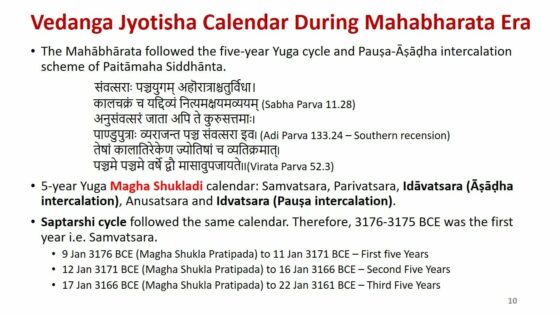
5. Solar eclipse on the day when Pandavas left for Vanavasa.
आसीन्निष्टानकॊघॊरॊनिर्घातश्चमहानभूत्।
दिवॊल्काश्चापतन्घॊराराहुश्चार्कमुपाग्रसत्॥(Sabhā Parva-72.21)
6. How Bhishma calculated the exile period of Pandavas in the 5-Year Magha Shukladi Calendar?
तेषांकालातिरेकेणज्योतिषांचव्यतिक्रमात्I पञ्चमेपञ्चमेवर्षेद्वौमासावुपजायतेII
तेषामभ्यधिकामासाःपञ्चद्वादशचक्षपाःI त्रयोदशानांवर्षाणामितिमेवर्ततेमतिःII (Virata Parva 47.3-4)
7. Mars was on retrograde between Chitra and Swati. After retrograde motion, Mars approached Jyeṣṭhā Nakśatra and appeared to be pleading to Anurādhā (also known as Maitra Nakśatra) to pacify her. Thereafter, Mars approaches Brahmarāśi and positions in Śravaṇa Nakśatra before Kurukshetra war.
ध्रुवःप्रज्वलितोघोरमपसव्यंप्रवर्तते|
चित्रास्वात्यन्तरेचैवधिष्ठितःपरुषोग्रहः॥ (Bhishma Parva 3.16)
कृत्वाचाङ्गारकॊवक्रंज्येष्ठायांमधुसूदन।
अनुराधांप्रार्थयतेमैत्रंसंशमयन्इव (Udyoga Parva 141.8)
वक्रानुवक्रंकृत्वाचश्रवणेपावकप्रभः।
ब्रह्मराशिंसमावृत्यलोहिताङ्गोव्यवस्थितः॥ (Bhishma Parva 3.17)
8. The identification of Brahmarashi.
वक्रानुवक्रंकृत्वाचश्रवणेपावकप्रभः।
ब्रह्मराशिंसमावृत्यलोहिताङ्गोव्यवस्थितः॥ (Bhishma Parva 3.17)
9. It was predicted before Mahabharata war that Venus was ready to go on retrograde.
शुक्रःप्रॊष्ठपदेपूर्वेसमारुह्यविशांपते,
उत्तरेतुपरिक्रम्यसहितःप्रत्युदीक्षते॥ (Bhishma Parva 3.15)
10. Mercury on retrograde? in three Nakshatras before Kurukshetra War.
त्रिषुपूर्वेषुसर्वेषुनक्षत्रेषुविशांपतेI
बुधःसंपततेअभीक्ष्णंजनयन्सुमहद्भयम् II (Bhishma Parva 3.27)
11. Kaumuda month (Karttika) was the month of Sharad Ritu.
कौमुदेमासिरेवत्यांशरदन्तेहिमागमे। (Udyoga Parva 8.17)
12. Observation of Super Moon or Harvest Moon or Lunar eclipse before Mahabharata War.
अलक्ष्यःप्रभयाहीनःपौर्णमासींचकार्त्तिकीम्,
चन्द्रॊऽभूद्अग्निवर्णश्चसमवर्णेनभस्तले॥(Bhishma Parva 2.23)
13. Ketu (Shveta Graha) positioned after crossing Chitra.
अभीक्ष्णंकम्पतेभूमिरर्कंराहुस्तथाग्रसत्I
श्वेतोग्रहस्तथाचित्रांसमतिक्रम्यतिष्ठतिII (Bhishma Parva 3.11.)
14. Rahu (Shyama Graha) positioned in Jyeshtha.
श्यामोग्रहःप्रज्वलितःसधूमःसहपावकःI
ऐन्द्रंतेजस्विनक्षत्रंज्येष्ठामाक्रम्यतिष्ठतिII (Bhishma Parva 3.15).
15. Venus and Mars were in conjunction on the 18th Day of War.
भृगुसूनुधरापुत्रौशशिजेनसमन्वितौ
चरमंपाण्डुपुत्राणांपुरस्तात्सर्वभूभुजाम् II (Shalya Parva 11:17)
16. When Moon was in Magha, no planet was visible in the Night (before Kurukshetra War).
मघाविषयगःसोमस्तद्दिनंप्रत्यपद्यतI
दीप्यमानाश्चसम्पेतुर्दिविसप्तमहाग्रहाःII (Bhishma Parva 17.2)
17. Mercury (Tivra Graha) was in Krittika.
कृत्तिकासुग्रहस्तीव्रोनक्षत्रेप्रथमेज्वलन्I
वपूंष्यपहरन्भासाधुमकेतुरिवस्थितःII (Bhishma Parva 3.26)
18. A lunar eclipse followed by a solar eclipse within 14 days before Kurukshetra war.
चतुर्दशींपञ्चदशींभूतपूर्वांचषॊडशीम्,
इमांतुनाभिजानामिअमावास्यांत्रयॊदशीम्॥
चन्द्रसूर्यावुभौग्रस्तौएकमासेत्रयॊदशीम्,
अपर्वणिग्रहावेतौप्रजाःसंक्षपयिष्यतः॥ (Bhishma Parva 3.28-29)
19. Prediction of the future occurrence of a solar eclipse based on the observation of moon just before the Mahabharata War.
सॊमस्यलक्ष्मव्यावृत्तंराहुरर्कम्उपेष्यति।
दिवॊल्काश्चपतन्त्येताःसनिर्घाताःसकम्पनाः॥(Udyoga Parva 141.10)
राहुश्चाग्रसदादित्यमपर्वणिविशांपतेI
चकम्पेचमहाकम्पंपृथिवींसवनद्रुमाःII (Shalya Parva 55.10)
20. A Pair of eclipses before the 36th year after Mahabharata war.
एवंपश्यन्हृषीकेशःसंप्राप्तंकालपर्ययम्,
त्रयॊदश्याम्अमावास्यांतान्दृष्ट्वाप्राब्रवीद्इदम्॥
चतुर्दशीपञ्चदशीकृतेयंराहुणापुनः,
तदाचभरतेयुद्धेप्राप्ताचाद्यक्षयायनः॥ (Musala Parva 3.16-17)
21. Saturn and Jupiter were in Vishakha Nakshatra before Kurukshetra war.
संवत्सरस्थायिनौचग्रहौप्रज्वलितावुभौ।
विशाखयॊःसमीपस्थौबृहस्पतिशनैश्चरौ॥ (Bhishma Parva 3.25)
22. Jupiter was on retrograde in Shravana and also occulted by Saturn before Kurukshetra War.
मघास्वङ्गारकॊवक्रःश्रवणेचबृहस्पतिः,
भाग्यंनक्षत्रमाक्रम्यसूर्यपुत्रेणपीड्यते॥ (Bhishma Parva 3.13)
23. Occultation of Rohini by Saturn.
रोहिणींपीडयन्नेषस्थितोराजञ्शनैश्चरः। (Bhishma Parva 2.23)
प्राजापत्यंहिनक्षत्रंग्रहस्तीक्ष्णॊमहाद्युतिः
शनैश्चरःपीडयतिपीडयन्प्राणिनोऽधिकम्॥. (Udyoga Parva 141.10)
24. Comet in Pushya Nakshatra.
अभावंहिविशेषेणकुरूणांप्रतिपश्यतिI
धूमकेतुर्महाघोरःपुष्यमाक्रम्यतिष्ठतिII (Bhishma Parva 3.12)
25. Karttika Amavasya: The first day of Kurukshetra War.
सप्तमाच्चापिदिवसादमावास्याभविष्यति |
सङ्ग्रामंयोजयेत्तत्रतांह्याहुःशक्रदेवताम् || (Udyoga Parva 140:18)
26. Balarama’s Pilgrimage and Krishna’s Diplomatic Mission.
चत्वारिंशदअहान्यअद्यदवेचमेनिःसृतस्यवै
पुष्येणसंप्रयातॊऽसमिशरवणेपुनरागतः
शिष्ययॊरवैगदायुद्धंदरष्टुकामॊऽसमिमाधव (9.33.5)
ततॊमन्युपरीतात्माजगामयदुनन्दनः
तीर्थयात्रांहलधरःसरस्वत्यांमहायशाः
मैत्रेनक्षत्रयॊगेसमसहितःसर्वयादवैः
आश्रयामआसभॊजसतुदुर्यॊद्ननमअरिंदमः
युयुधानेनसहितॊवासुदेवसतुपाण्डवान
रौहिणेयेगतेशूरेपुष्येणमधुसूदनः (9.34.12-14)
27. Bhishma Moksha or Nirvana 56 days/ 88 days/ 92 days after the 10th day of Mahabharata war
28. Bhishma Nirvana: Magha Shukla Ashtami/ Bhishma Ekadashi/ Bhishma Dvadashi.
The Mahābhārata War lasted for eighteen days.
After the war, Pāndavas stayed on the banks of Ganga roughly for a month.
Thereafter, Yudhiṣṭhira was coronated in Hastinapur. (Pushya Purnima?)
Yudhiṣṭhira and Krishna met Bhishma on the next day. Krishna indicated that Bhishma had only fifty-six days to live.
Yudhiṣṭhira came back to Hastinapur and lived there for fifty nights.
Yudhiṣṭhira confirmed that Uttarāyaṇa had already commenced. Therefore, he left Hastinapur and met Bhishma on the fifty-first day from the day of his last meeting with Bhishma.
सनिर्ययौगजपुरात्याजकैःपरिवारितःI दृष्ट्वानिवृत्तमादित्यंप्रवृत्तंचोत्तरायणम्II
Bhishma told Yudhiṣṭhira that Uttarāyaṇa had already commenced and hinted the date as Māgha Śukla Pañchamī.
दिष्ट्याप्राप्तोऽसिकौन्तेयसहामात्योयुधिष्ठिरI परिवृत्तोहिभगवान्सहस्रांशुर्दिवाकरःII
माघोऽयंसमनुप्राप्तोमासःपुण्यःयुधिष्ठिरI त्रिभागशेषःपक्षोयंशुक्लोभवितुमर्हतिII
External Literary Evidence of Mahabharata War Date
29. Saptarshis reached Magha Nakshatra when Yudhishthira was ruling in Indraprastha. Vayu Purana 99/419, Brihat Samhita 13-3.4, Vishnu Purana 4.24.105, Kaliyuga Rājavrittānta
यदायुधिष्ठिरोराजाशक्रप्रस्थेप्रतिष्ठितःI
तदासप्तर्षयःप्रापुर्मघाःपितृहितेरताः॥
पञ्चसप्ततिवर्षाणिप्राक्कलेःसप्ततेद्विजाः
मघास्वासन्महाराजेशासत्युर्वीम्युधिष्ठिरे॥ (Kaliyuga Raja Vrittanta)
30. Jinavijaya refers to Jain Yudhishthira era that commenced 468 years after the epoch of Kaliyuga (3101 BCE).
31. Vyāsa was the author of eighteen Purāṇas. Purāṇas refer to the position of the celestial pole star in the tail of Śiśumāra (Draco) constellation. Bhāgavata, Matsya, Brahmānḍa, Vishnu and Vāyu Purāṇas give the description of the stars of Śiśumāra (Draco) constellation. Based on these Puranic descriptions of Śiśumāra constellation, Alpha Draconis star (Thuban) can be identified as Dhruva. Alpha Draconis star (Thuban) was the celestial pole star around 3900-1800 BCE.
Bhāgavata Purāṇa (2.2.24, 5.23.4-8 & 6.6.14), Brahmānḍa Purāṇa (1.1.85 and 2.23.99), Matsya Purāṇa (125.5-9 & 127.16-25), Vishnu Purāṇa (2.12) and Vāyu Purāṇa (1.101).
32. Jyotirvidabharanam of Kalidasa: Yudhishthira Era lasted for 3043 years.
33. Rajatarangini indicates that Mahabharata war took place around 2449 BCE but it also says that Kurukshetra war occurred at the end of Dvapara according to tradition.
(भारतंद्वापरान्तेभूदवार्तयेतिविमोहिताः
केचिदएताममृषातेषांकालसंख्यामप्रचक्रिरेII 1.49
शतेषुषट्सुसार्धेषुत्र्यधिकेषुचभूतले
कालेर्गतेषुवर्षाणांअभूवनकुरुपाण्डवाःII 1.51
आसन्मघासुमुनयःशासतिपृथ्वींयुधिष्ठिरेनृपतौ
षड्द्विकपञ्चद्वियुतःशककालस्तस्यराज्ञःII 1.56)
34. Entire Kashmiri tradition follows the epoch of Saptarshi or Shastrabda calendar that commenced in 3076 BCE.
35. Aryabhata mentions that Kaliyuga or the fourth Yugapada commenced from Prabhava Samvatsara before Kurukshetra war.
36. According to Yallayya (author of Jyotisha Darpana and a commentary on Aryabhatiyam), Pāndava Saṁvat commenced 12 years after the epoch of Kaliyuga. [कल्यब्दाःरूपरहिताःपाण्डवाब्दाःप्रकीर्तिताः].
37. Kutūhalamañjari refers to the year of Yudhiṣṭhira’s coronation in Indraprastha as Surya-sunuja-nripa-saka. It informs us that Varāhamihira was born in the 8th tithi of the bright half of Chaitra month, in Jaya saṁvatsara and the year 3042 of Yudhiṣṭhira era.
(स्वस्तिश्रीनृपसूर्यसूनुज-शकेयातेद्वि-वेदा-म्बर-त्रैर् मानाब्दमितेत्वनेहसिजयेवर्षेवसन्तादिके।चैत्रेश्वेतदलेशुभेवसुतिथावादित्यदासादभूद्वेदाङ्गेनिपुणोवराहमिहिरोविप्रोरवेराशीर्भिः॥).
38. Abul Fazl’s Ain-i-Akbari gives the chronological history of Bengal starting from the Mahābhārata era. Seemingly, King Bhagadatta of Prāgjyotiṣa (Assam) and his descendants reigned over Bengal for 2318 (2418?) years. Interestingly, Abul Fazl says; “The First Raja (Bhagadatta) came to Delhi by reason of his friendship for Raja Durjodhan and fell manfully fighting in the war of the Mahabharat, 4096 years previous to the present time.”
Traditional Evidence of Mahabharata War Date
39. Gita Jayanti: Margashirsha Shukla Ekadashi.
40. Vamshavalis of Ror Dynasty refer to Pandava Samvat.
41. Jammu Vamshavalis: Madra King Shalya of Mahabharata era defeated Jammu King Shiva Prakash and Jammu became part of Madra Kingdom. According to Gulabnama written by Diwan Kriparam, Jyoti Prakash and Sarva Prakash (Sari Prakash or Jai Dev), the descendants of King Shiv Prakash of the Mahābhārata era re-conquered Jammu with the assistance of Charak clan and established their rule in the 444th year of Kaliyuga.
Epigraphic Evidence of Mahabharata War Date
42. Aihole Inscription refers to Saka 556 elapsed and Mahabharata 3135 elapsed.
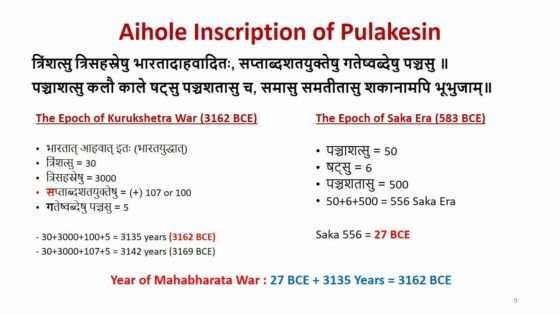
43. Hisse Borala inscription: Saka 380 and Saptarshis in Uttara Phalguni Nakshatra.
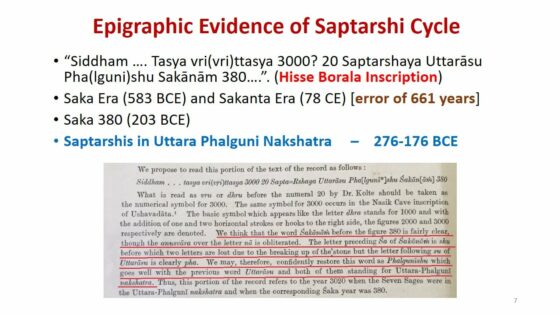
44. Nidhanpur Inscription of Bhaskaravarman: Bhagadatta and Vijaya (Arjuna) flourished 3000 years before Pushyavarman.
45. Janamejaya copper plates found in Karnataka.
46. The Jaisalmer Vaiṣṇava temple inscription of Mūlarāja refers to the year 4898 of Yudhiṣṭhira era.
47. The two inscriptions of the early Chālukya Viṣṇuvardhana are the earliest inscriptions dated in the year of Kaliyuga 2625 and 2628.
Chronological Evidence of Mahabharata War Date
48. The Date of Buddha Nirvana and Mahavira Nirvana and the chronology given in Buddhist and Jain sources.
49. The Birth year of Adi Sankara.
50. The coronation of Mahapadma Nanda: 1500/1050 years after Kurukshetra war.
51. Rajatarangini: King Gonanda I was the contemporary of Jarasandha and the chronology of Kashmir.
52. The Epochs of Two Saka eras (Old Saka era [Saka Samvat] and Later Saka era [Sakanta Samvat]).
Scientific Evidence of Mahabharata War Date
53. Dating of Burckle crater for submergence of Dwarka and Kavatapuram of Pandyas in a Tsunami.
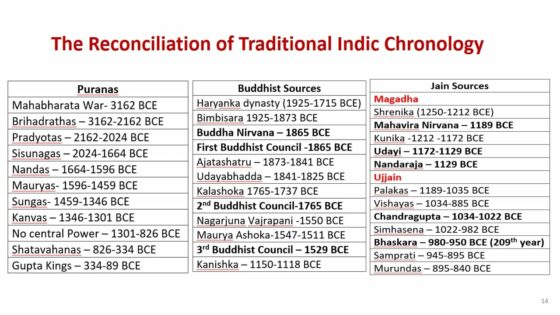
Featured image courtesy: Pinterest.
Vedveer Arya
Latest posts by Vedveer Arya (see all)
- How Salaries Were Paid to Temple Staff in Early Medieval Bharat - July 27, 2024
- A Genealogical Account of Bhrigu Gotra from Saptarshis - July 27, 2024
- Saptarshis: Lineages of Angirasa gotra from 14050 BCE - July 27, 2024

